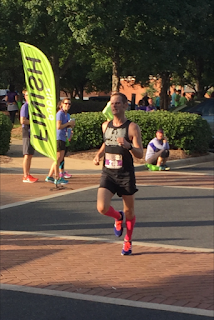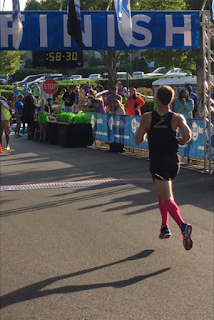 |
| You can find me in the right third of the frame in the obnoxiously pink pacer shirt. I'm right behind Chad Crockford in the JITFO singlet, who would go on to win the marathon. |
I noticed many familiar faces at the starting line, including some really fast folks from all around the Charlotte metro area. Most of those speedsters would speed ahead at the gun and never be seen again. A good twenty or so people spotted me with Matt L. (my pacing partner) in our conspicuously pink pacer shirts and huddled around us. Bryan, one of my local training buddies, met up with us intending to break 1:30 for a half marathon PR and tune-up for his focus marathon in January.
When the go signal went off, dozens of people charged ahead. Some faded back, but it seemed like there were a lot of runners out there running faster than a 1:30 half/3:00 full pace. As was always the case, we would see many of them again. With the tall buildings in uptown Charlotte, my GPS watch was jumping around for pace readings, and out of our large group, no two watches said the same thing, so I largely paced by feel. It worked out well enough; we came to the first mile marker at 6:51.
 |
| Somewhere in the first mile. At least a score of runners were on the 1:30/3:00 bandwagon. |
As with any rolling course, I briefed my tag-alongs that we would shoot for equal effort on the ups and downs and end up with reasonably even splits. The first half of the Charlotte course--which shares all but the last 500 meters of the half marathon course--is a beautiful, residential route that traverses the Meyers Park, Dilworth, and Southend neighborhoods. With lots of crowd support and appealing streetscapes, the miles went by with relative ease. We climbed the infamous Morehead Street hill at mile 8+ and started shedding some followers. At this point, Lucy, a friend of another running buddy, overtook the first female who faded back to us and became the lead female marathoner. We had banked a good 20-25 seconds on the race clock before that hill and were perfectly comfortable to give some of it back. After going up most of the hill, taking a brief loop through Dilworth, and then climbing the rest of Morehead, we had given back about 10 seconds and were a cumulative 13 seconds ahead of pace.
Many of the half marathoners in our group started to fade in Southend with all but the last 5k of their race remaining. Bryan stayed with us, but he was less talkative. I positioned myself at the front of the pace group once we turned onto Mint Street at mile 11.8. The headwind here was palpable, so I figured I would offer drafting services to half marathon finishers and Lucy, who had her eyes on a winning marathon spot. A little more than half a mile from the half marathon finish, I noticed Bryan lagging behind by a few strides. With our banked seconds, he was still on pace for a sub-1:30 and big PR, but this was no time to get complacent and fall off. I drifted back and ran at his shoulder trying to draft him back to the group. Me made up the gap, and by the time the course split, he was set up for one final quarter-mile push that propelled him to a 1:29:46, which beat his stretch goal.
As we full marathoners veered around the BB&T Ballpark and out of sight of the finish line, our 2nd half pacers, Paul and Ryan, were waiting at the mile 13 mark to relieve us of our culpability...er...responsibility. By the time we reached the certified 13.1 mark, we were still 10+ seconds ahead of pace. Since it was getting warmer (at least at a 6:52 pace), I shed my pacer shirt and was down to a singlet. I decided to run with the group to offer additional support and maybe benefit from having the fresh Ryan and Paul as pacers. Miles 14-16 not only were the least scenic of the course, but they had the strongest headwind, so I tucked in behind Paul, who was a good six inches taller than me. I took my turn running into the wind too, but I allowed myself to work off the new pacers' fresh legs whenever I could.
 |
| This is probably mile 14ish. From left: Ryan M. (second shift pacer), Lucy (lead female), and me (down to my Reckless Running singlet |
Again, the conversation and general sense of security in running with a group made the miles go by quickly, and we continued to bank a few more seconds per mile as we carried on. By mile 18, I accepted that I was going to have to stop at a port-a-potty, so as soon as I bird-dogged one on The Plaza, I surged ahead and took care of the need as quickly as possible. When I got back on the road, I could see Ryan and Paul's pink pacer shirts a couple hundred meters ahead of me, and it looked like Lucy and a couple other sub-three hopefuls were hanging strong with them. I settled into a closing pace, but I intended to take my sweet time catching up to the sub-3 group to avoid repeating the stupid mistake I made at Boston. I had chosen my potty stop well because the next couple of miles were flat enough to pick up the pace a bit and negate the small amount of time I lost in the facilities.
By mile 20, I was back on pace for three hours, but the pace group was still far ahead and not coming back to me. It was evident that they were going to go under three by a considerable margin, so I abandoned any notion of catching up to them and resolved to run solo for the last 10k. Here and there, I would pass runners that had fallen off the three hour pace group, and I tried to get them to tag along with me because I technically was still on pace for sub-three, but most of them had hit their wall and were fading. As each mile went by, I kept on banking a few more seconds, much like I did as a pacer for the first half, but with 2.5+ hours of running on my legs, the idea of a sub-three finish wasn't seeming any more certain.
 |
| Circa mile 24. I'm on my own and tired, but still coherent enough to give an Aswell-style thumbs-up. |
Mile markers 23 and 24 came along, both confirming that I was 18-20 seconds ahead of pace. I had not bonked, but the legs were protesting and my breathing was getting heavy. Still, with each mile marker, I remember telling myself something like, "You can't run 24 miles of a sub-three marathon and NOT get the sub-three finish!"
The 25th mile was a pleasant departure from the roads and took me on a greenway near the medical center in midtown. The gun clock at mile 25 read about 2:51:30ish, which was still 20ish seconds ahead of pace, but anyone who has run the Novant/Thunder Road marathon in the last three years knows that mile 26 is one, tough, uphill slog up the length of Stonewall. This was the reason for all the previously banked time. Marathoners like to joke that a marathon has two "halves:" the first 20 miles and the last 6.2. Well for me, this race's two "halves" were the first 25 miles and the last 1.2! With my banked time, a 7:00 pace mile would still set me up for a sub-three finish, but a 7:10 would be too close for comfort. I tried to just look ahead and run, but I couldn't resist glancing at my watch here and there. With the instantaneous pace jumping back and forth between 7:05 and 7:10, I had tragic visions of the finish clock flipping from 2:59:59 to 3:00:00 right in front of me. Of course, that was just the last mile talking. The only real thing to do was to HTFU and do the damn thing! I remember what my onetime nemesis Sam said during a track workout a couple months ago: "Chas always has a little something left." So I dug in and started running under a 7:00 pace again.
When I got to the top of Stonewall and turned right on Mint (not even noticing the mile 26 marker), I focused on the finish line, which was still so far away! I knew it was going to be close, so I let it all out. I crossed the finish line in 2:59:52, fifteen seconds behind Lucy, who held on to the lead to get the overall female win.
 |
| Crossing the finish line just under three hours. For the life of me, I have absolutely no recollection of high-fiving Hugo the Hornet, but here's photographic proof. |
This sub-three finish meant at least as much to me as my first sub-three and current PR from last year. This race, although it was within a minute of my PR, was on a much harder course and thus gave me a sense of validation. Running a lot of 3:00+ marathons and having one sub-three finish means I could have had a good a good day and gotten lucky once. Running a second sub-three lets me confidently think of myself as a sub-three marathoner. Now on to loftier goals yet to be decided...
Here is my Strava data for the race.
 |
| The double-Aswell pose! |
























